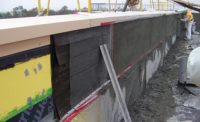Stucco, EIFS and Direct Applied Systems are all good claddings, yet none of them are perfect for every building, climate or usage. This is particularly true of ceiling or soffit construction.
Cement plaster, also called stucco, is the oldest cladding and has been applied to ceilings for more than 100 years. Most often, a type of rib lath was used. EIFS is a good cladding, but for ceiling and soffit applications, we prefer to remove the foam and this becomes a DAS (EIFS without foam plastic). Some call it DEFS, but by either name, it is excellent for exterior ceilings and soffits in all climates. DAS is fast, economical and can even be a fire-rated ceiling. The only drawback would be abuse resistance. However, how abuse-resistant does a ceiling or soffit have to be?
What Not to Use on Ceilings
Continuous insulation is more common today. For walls, it is great, but ceilings can be problematic. Most building officials and fire marshals frown when they see CI foam plastic on ceilings and explain why DAS is preferred over EIFS for ceiling applications. The rationale is that in the event of a fire, foam plastic melts and becomes a hot, gooey liquid. This is not ideal for occupants trying to get out of the building or first responders trying to get in. In addition, there is no real need for CI on ceilings; you have plenty of room for more cavity insulation. This explains the popularity of DAS for ceilings, particularly large ceilings in our schools.
The foam plastic issue is the same with cement plaster. Cement plaster has been used on school ceilings for over a century. The performance and public safety record for these ceilings has been nothing less than outstanding. We still find cement plaster ceilings in elementary, middle and high schools littered across the country. The inherent one-hour fire rating at 5/8-inch thickness and cement’s abuse resistance have made stucco ceilings a favorite. Designers could easily incorporate suspension systems for furring and lath. The designer simply put an arrow to the ceiling and noted cement plaster, and the pros took care of the rest.
The success of stucco ceiling installations was directly related to the training of craft workers and the conformity to a basic proven assembly. ASTM even adopted this assembly in the standards. The Uniform Building Code followed suit with Section 1707, stating that the weather-resistive barrier may be omitted behind lath and cement plaster under roofs and eave projections. It is historical to apply the appropriate lath directly to the joist or furring, eliminating sheathing or a water resistant barrier. This is how rib lath was developed; the ribs help stiffen the lath and keep it from flexing too much when the plaster is applied. Hi-rib lath had a rigid V-rib and was meant to span joists that spanned 24 inches on-center. While not codified, hi-rib was only intended for residential overhangs that did not extend beyond 24 inches. Using hi-rib lath on larger ceilings or soffits is not recommended. The V-shape of the rib cuts a line in the plaster and can induce cracking along that weakened section.
Backing Up the Lath
Foam plastic is also not recommended behind cement plaster applied to ceilings. The use of any solid backing behind the lath on ceilings has ramifications and should be carefully considered. The lath on ceilings was meant to flex a little. The slight flex of the lath on ceilings is generally beneficial. We want cement plaster to encase the lath; this is most important on ceilings and critical for ceilings in our schools. The plasterer pushes the first, or scratch, coat of cement up and through the small lath openings. The cement is forced up and kind of folds over to key with the lath. Once the cement sets, the lath and cement plaster become inseparable. If the plasterer fails to push the cement up with sufficient force, the lath flexes back down as the plasterer releases pressure because the cement is only semi-keyed to the lath, falling off onto the plasterer. This is hard work, and having the plaster fall down on your chest is an immediate failure.
Essentially, the historic practice of no solid backing was a self-policing practice to ensure the cement plaster would never come separated from the lath.
Adding a solid backing behind the lath makes the plastering easier. However, it also removes the self-policing benefits to ensure it is well-keyed to the lath. While I do not think any plasterer would intentionally cheat, the work is hard and one gets tired working overhead, and if the plaster sticks, they have no idea if it sticks for life. Before designing or installing a ceiling with foam plastic or stucco with a backing, weigh the benefits to the risk. DAS or stucco with no backing is typically preferred on ceilings, particularly in our schools.






Report Abusive Comment